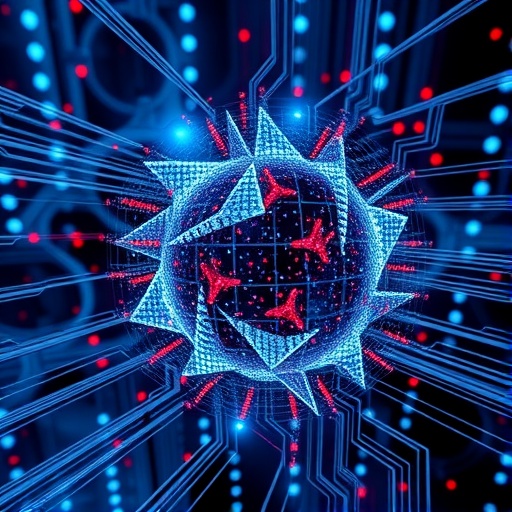In a groundbreaking development poised to revolutionize the landscape of spintronic technology, researchers at Johannes Gutenberg University Mainz (JGU) have successfully engineered three-dimensional magnetic skyrmion tubes within synthetic antiferromagnetic multilayers. This achievement marks a significant departure from previous two-dimensional skyrmion studies and opens promising new avenues for advanced data storage, quantum computing, and brain-inspired computational architectures. The research, published in Nature Communications on September 26, 2025, reports the observation of a non-reciprocal skyrmion Hall effect, revealing that these novel hybrid chiral skyrmion tubes exhibit markedly distinct dynamics compared to their two-dimensional counterparts.
Spintronics, an emergent domain that exploits the intrinsic spin of electrons as opposed to their charge, has long been heralded as the future paradigm for information processing and storage. Skyrmions, diminutive topological quasi-particles characterized by swirling magnetic moments, serve as robust nanoscale information carriers in spintronic devices. Previously confined largely to two-dimensional thin films, skyrmions afford the potential for dense, low-power memory elements. The Mainz team’s creation of three-dimensional skyrmion tubes in synthetic antiferromagnets represents a quantum leap by extending the dimensionality and thereby augmenting the data storage capacity exponentially.
Traditional skyrmions exhibit uniform or homogeneous chirality, meaning their spin textures twist in a consistent manner through the material’s thickness. These uniform skyrmions respond predictably to applied currents, moving laterally with a defined skyrmion Hall angle. However, the synthetic antiferromagnetic multilayers created by the Mainz researchers reveal an intricate non-uniform twisting—referred to as hybrid chirality—in the skyrmion tubes. This complex magnetic architecture breaks reciprocity in their motion, causing the skyrmion tubes to behave fundamentally differently from two-dimensional skyrmions. This behavior is pivotal, as it allows the third spatial dimension to be harnessed for data encoding in ways previously unattainable.
The synthesis of these three-dimensional skyrmion tubes involved precise thin-film deposition techniques, where layers were engineered to achieve antiferromagnetic coupling such that magnetizations cancel outwardly. This magnetic compensation suppresses stray fields and stabilizes skyrmion tubes with hybrid chiral structures. Verification of their three-dimensional configuration employed cutting-edge imaging modalities at the Jülich Research Center, utilizing synchrotron X-ray sources including BESSY II in Berlin and the Swiss Light Source at the Paul Scherrer Institute in Switzerland. These advanced facilities enabled the researchers to probe both static configurations and dynamic responses under applied electrical currents with unprecedented spatial and temporal resolution.
The revelation that skyrmion tubes exhibit a non-reciprocal Hall effect elucidates new physics underlying topological magnetic textures in three dimensions. Unlike the predictable transverse displacement of two-dimensional skyrmions under current flow, the hybrid skyrmion tubes demonstrate asymmetric velocity profiles contingent on the direction of current, resulting in a form of directional memory transport. This non-reciprocity affords an additional control parameter for manipulating magnetic information carriers and thereby enhancing information processing fidelity and density.
Such innovations hold profound implications for next-generation computing paradigms, particularly brain-inspired or neuromorphic computing. These computational platforms seek to emulate the complex, nonlinear neuronal processes found in biological neural networks. The tridimensional nature of the skyrmion tubes allows for more nuanced magnetic states that mimic neuronal activity more faithfully than planar skyrmions. Consequently, these structures can serve as hardware components for neuromorphic circuits that promise substantially improved energy efficiency and adaptability for complex tasks such as pattern recognition, learning, and autonomous decision-making.
Beyond neuromorphic architectures, the elucidation of 3D skyrmion dynamics extends potential applications into the realm of quantum computing. The inherent topological protection and multi-dimensional topology of hybrid skyrmion tubes may furnish qubit implementations that are less susceptible to decoherence—a chief hurdle in realizing practical quantum machines. The non-uniform chirality introduces richer quantum states and coupling mechanisms that can be harnessed for robust quantum information processing and error correction protocols.
Operationalizing this technology into commercial spintronic devices will necessitate further interdisciplinary research combining materials science, condensed matter physics, and electrical engineering. Challenges lie primarily in the large-scale fabrication of uniform hybrid skyrmion tubes and their integration with existing semiconductor technologies. Nevertheless, the methods employed here—standard thin-film deposition and advanced synchrotron-based characterization—indicate that scalable manufacturing is feasible, positioning this breakthrough as a cornerstone for future data storage and quantum information technologies.
In summary, the Mainz research team’s work constitutes a pivotal advance in the study of magnetic skyrmions, presenting for the first time a controllable, three-dimensional skyrmion topology with distinct translational dynamics in synthetic antiferromagnets. By exploiting hybrid chirality, these skyrmion tubes reveal a non-reciprocal Hall effect that not only enriches the fundamental understanding of topological magnetic phenomena but strategically enhances the functional capacity of skyrmions as next-generation information carriers. This multidimensional magnetic vortex could redefine the roadmap toward ultra-dense, energy-efficient information technologies central to the digital future.
Subject of Research: Not applicable
Article Title: Observation of a non-reciprocal skyrmion Hall effect of hybrid chiral skyrmion tubes in synthetic antiferromagnetic multilayers
News Publication Date: 26-Sep-2025
Web References:
https://doi.org/10.1038/s41467-025-63759-7
Image Credits: Ill./©: Mona Bhukta
Keywords
Three-dimensional skyrmions, hybrid chiral skyrmion tubes, synthetic antiferromagnets, spintronics, non-reciprocal skyrmion Hall effect, magnetic vortices, data storage, neuromorphic computing, quantum computing, topological magnetism, thin-film deposition, advanced synchrotron imaging




